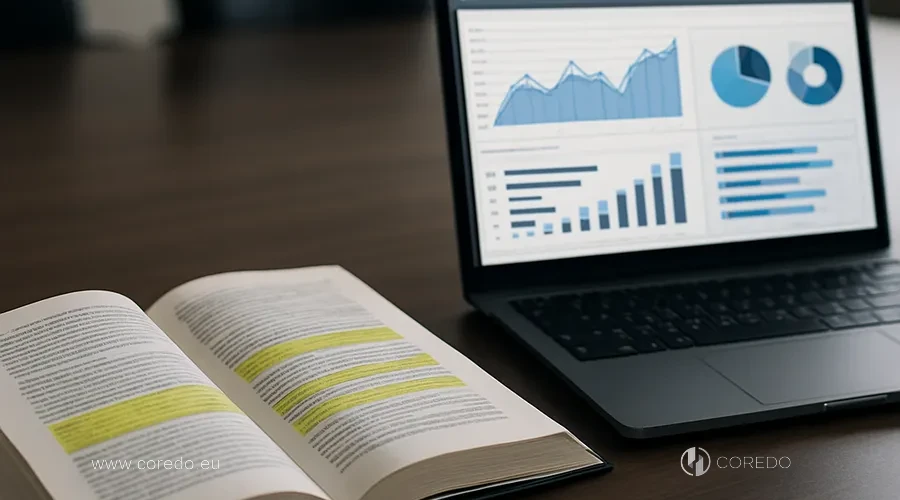AML compliance – is not a formality but a strategic necessity for any business seeking international expansion, obtaining financial licenses and long-term resilience. Violating requirements leads not only to fines and criminal liability, but also to loss of access to banking services, licenses and investments. The experience of the COREDO team shows that proper implementation of AML compliance becomes a key factor in successful registration of legal entities, obtaining licenses and protecting a business from sanctions.
Basics of AML Compliance: key concepts

Key elements of AML compliance include:
- Know Your Customer (KYC): identification and verification of customers, including legal entities and beneficial owners (Beneficial Ownership).
- Customer Due Diligence (CDD): in-depth customer screening taking into account a risk-based approach (Risk-Based Approach).
- Transaction Monitoring: monitoring of transactions to detect suspicious activity and preparation of Suspicious Activity Reports (SAR).
- Sanctions Screening: client screening against sanctions lists (OFAC, EU, UN).
- Politically Exposed Persons (PEP): identification of individuals with heightened political risk.
- Compliance Officer / MLRO: appointment of a person responsible for compliance and reporting.
- Anti-Terrorism Financing (ATF): integration of measures to combat terrorist financing.
Stages of implementing AML compliance in a company

Implementing AML compliance requires a phased approach based on analysis of the business model, risks, and jurisdiction-specific characteristics. The solution developed at COREDO for international clients includes the following steps:
- Analysis of current processes and risks: Assessing vulnerabilities, identifying client and transaction types, analyzing compliance with global and local AML requirements.
- Development of the company’s AML policy: Establishing an AML policy framework structure taking into account the risk assessment methodology and KYC, CDD and EDD procedures.
- Appointment of a Compliance Officer / MLRO: Defining roles and responsibilities, training according to international standards.
- Employee training: Developing compliance training programs, conducting workshops on detecting suspicious transactions, working with sanctions lists, and internal control.
- Implementation of internal procedures: Creating a system of Internal Controls and Procedures, process automation for transaction monitoring and record keeping.
- Maintaining reporting and documentation: Establishing Record Keeping and Reporting, configuring systems for data storage and transfer, ensuring Data Privacy in AML.
- Conducting an independent audit: Organizing Independent Audit and Testing, preparing for regulatory inspections, adjusting policies based on audit results.
AML policy: structure and content

An effective AML policy for a company: is not just a set of documents, but a living tool for managing risks and complying with regulators’ requirements. COREDO’s experience shows that the structure of an AML Policy Framework should include:
- Definition of goals and objectives: Formulation of the AML program’s mission, description of key risks and strategic objectives.
- Customer and beneficial owner identification procedures: Step-by-step instructions for Legal Entity Identification, KYC, Beneficial Ownership, CDD and EDD.
- Risk assessment methodology: Use of Risk Assessment Methodology, definition of risk criteria, configuration of Risk Profiling.
- Transaction monitoring and detection of suspicious operations: Description of Transaction Monitoring, procedure for preparing and filing SAR.
- Reporting and record keeping: Record Keeping and Reporting regulations, requirements for data storage and protection.
- Interaction with regulators: Procedure for providing information, audit preparation, response to inquiries.
AML and KYC: how to integrate processes

В работе COREDO интеграция AML и KYC реализуется через:
- Customer Due Diligence (CDD): basic customer checks, collection and analysis of documents.
- Enhanced Due Diligence (EDD): in-depth checks for high-risk clients, including PEPs and complex beneficial ownership structures.
- Legal Entity Identification: analysis of a legal entity’s structure, identification of ultimate beneficiaries.
- Risk-Based Approach: tailoring verification procedures according to the risk level, automating processes using AML compliance Software Vendors.
AML processes: automation and technologies

Modern technologies are radically changing the approach to AML compliance. Automated AML solutions can reduce operating costs, increase accuracy and the scalability of an AML program.
Key technologies that COREDO implements for clients:
- Automated AML Systems: automatic screening against sanctions lists, integration with global databases.
- Machine Learning in AML: use of AI algorithms to analyze transactions, detect atypical patterns and prevent compliance fatigue.
- Transaction Monitoring: real-time transaction monitoring, setting triggers for SARs.
- Data Privacy in AML: protection of personal data and confidentiality of information during processing and storage.
AML compliance in Europe, Asia and Africa
Regulatory requirements for AML compliance vary by country, but the FATF global standards remain the foundation for all jurisdictions. COREDO’s experience covers company registration and obtaining licenses in the EU, Singapore, Dubai, the United Kingdom, where their own regulations and procedures apply.
- In Europe: strict requirements for beneficial ownership, mandatory Registration of legal entities, regular audits, integration with national and European sanctions lists.
- In Asia (Singapore, Dubai): emphasis on corporate structure transparency, fast registration procedures, mandatory maintenance of registers of controllers and nominee directors, licensing of corporate service providers.
- In Africa: the difficulty of implementing AML compliance due to insufficient digitization, limited access to global databases, and the need to adapt procedures to local conditions.
Training and AML staff audit
An effective AML program is impossible without regular staff training and independent audits. At COREDO, training is built on the principles of Compliance Training Programs, covering:
- Fundamentals of AML compliance and KYC.
- Working with sanctions lists and identifying PEPs.
- Risk assessment methodology and SAR preparation.
- Record keeping and data protection.
Independent AML audit (Independent Audit and Testing) includes:
- Reviewing the compliance of policies and procedures with international and local requirements.
- Analysis of the effectiveness of Transaction Monitoring and Record Keeping.
- Preparation for regulator inspections, and adjustment of processes based on audit results.
How to assess the effectiveness of an AML program
- Number of detected suspicious transactions (SARs).
- Speed and accuracy of customer verification (KYC, CDD, EDD).
- Proportion of automated processes in the AML program.
- Results of independent audits and compliance with regulatory requirements.
- Scalability of AML Programs: the system’s ability to adapt to business growth and new markets.
Practical steps for entrepreneurs
The COREDO team has developed a checklist for implementing AML compliance in an international company:
- Assess risks and identify types of clients, transactions, and jurisdictions.
- Develop an AML policy framework taking into account global and local requirements.
- Appoint a competent Compliance Officer / MLRO.
- Organize employee training on key aspects of AML and KYC.
- Implement automated AML solutions for transaction monitoring and screening against sanctions lists.
- Ensure proper record-keeping and regular reporting.
- Prepare for an independent audit and adjust processes based on audit findings.
AML compliance as the foundation of a sustainable business
AML compliance is not only protection against risks, but also a foundation for scalable, sustainable, and competitive business. Compliance with global AML standards, integration of automated solutions, regular employee training, and independent audit are key elements that allow companies to operate successfully in Europe, Asia, and Africa.
Key stages in implementing AML compliance
| Stage | Description | Key actions |
|---|---|---|
| risk analysis | Assessment of current processes and risks | Conducting risk assessment, identification of vulnerabilities |
| Policy development | Creating the company’s AML policy | Defining objectives, procedures, responsible parties |
| Appointment of a responsible person | Selection of an AML Officer/MLRO | Defining roles and responsibilities |
| Employee training | Conducting AML training | Program development, conducting training sessions |
| Implementation of controls | Implementation of internal procedures | Development and implementation of internal control procedures |
| Maintaining documentation | Maintaining reporting and documentation | Establishing a reporting system and document storage |
| Audit | Conducting an independent audit | Audit preparation, compliance check |
- AML compliance is a mandatory requirement for legally conducting business abroad.
- Implementing AML compliance requires a comprehensive approach: from policy development to employee training and process automation.
- Technology and automation help reduce risks and increase the effectiveness of the AML program.
- Particular attention should be paid to requirements in different jurisdictions and to regularly updating the AML policy.
- AML compliance is not only protection against risks but also a competitive advantage for the business.